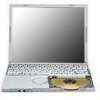Panasonic CF-W8EWDZZ2M Reference Manual - Page 41
Sleep or Hibernation Functions, Starting Up Your Computer Quickly, Precautions
 |
UPC - 092281897196
View all Panasonic CF-W8EWDZZ2M manuals
Add to My Manuals
Save this manual to your list of manuals |
Page 41 highlights
Sleep or Hibernation Functions 41 Starting Up Your Computer Quickly The sleep or hibernation functions allow you to shut off the computer without closing programs and documents. You can quickly return to the programs and documents that you were working on before sleep or hibernation. Function Sleep Hibernation Data is saved to Memory Hard disk Recovery time Short Rather long Power supply Required. (If power is not supplied, all data will be lost.) Not required. (However power is slightly consumed to keep the hibernation.) Precautions z Connect the AC adaptor if the computer will be in sleep for a long period of time. If you cannot use the AC adaptor, use hibernation instead. z Using sleep or hibernation repeatedly may cause malfunction of the computer. To stabilize computer operation, restart Windows regularly (about once a week) without using sleep or hibernation. z Save the necessary data. z Close files you have opened from removable disks and network drives. z The password you set in the Setup Utility is not requested at resuming. You can use the Windows password for security in sleep or hibernation. In the default setting, the Windows password will be requested to resume. z Do not enter sleep or hibernation in the conditions below, otherwise the data or file may be corrupted, sleep or hibernation may not work, or malfunction may occur in the computer or the peripheral devices. • When any of the hard disk drive indicator and the SD Memory Card indicator is on (accessing drive or card). • When the CD/DVD drive indicator is blinking (accessing drive). • When playing/recording audio files or displaying DVD-Video such as MPEG files. • When playing a DVD-Video. • When writing to a disc. • When using communication software or network function. • When using peripheral devices. (If peripheral devices fail to work normally, restart the computer.) z The computer does not enter sleep or hibernation immediately after resuming. Wait approximately one minute.















